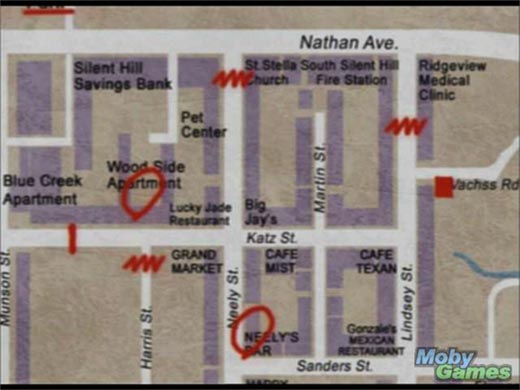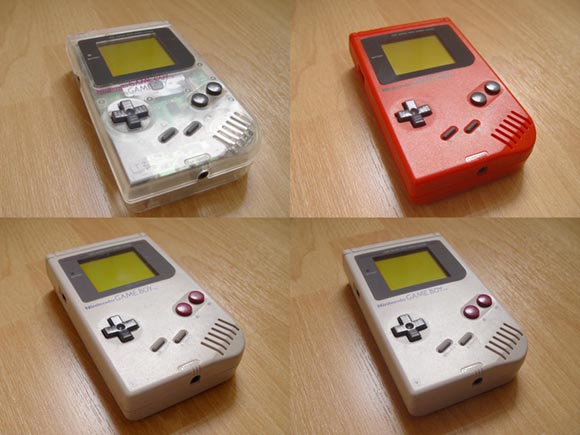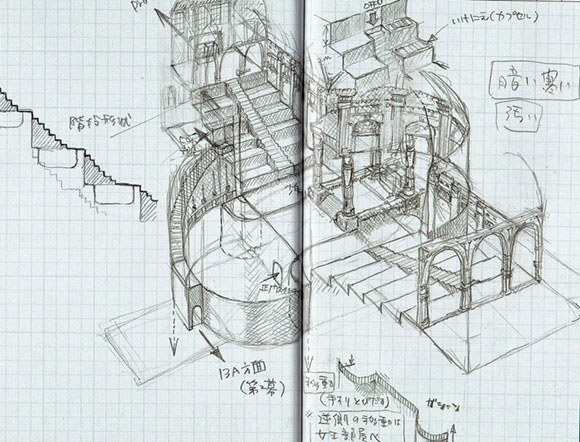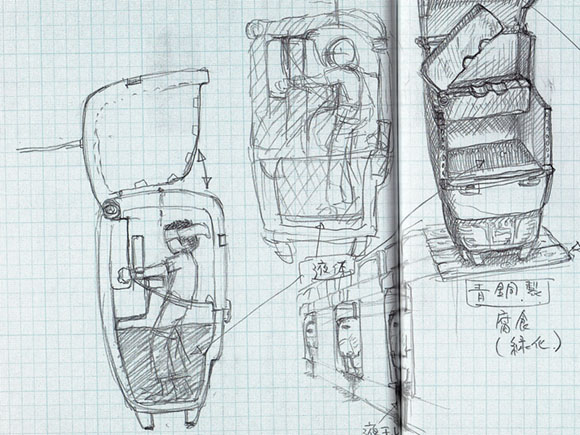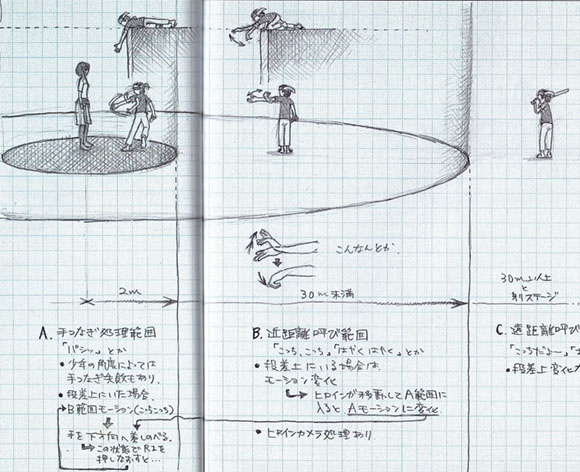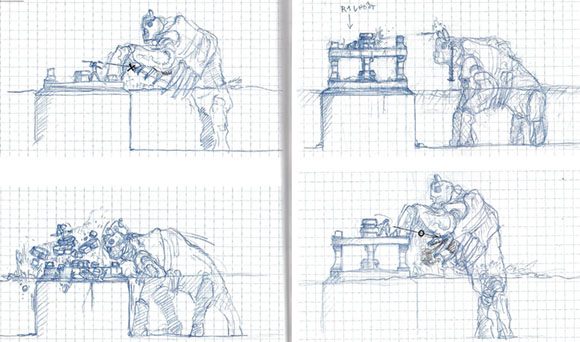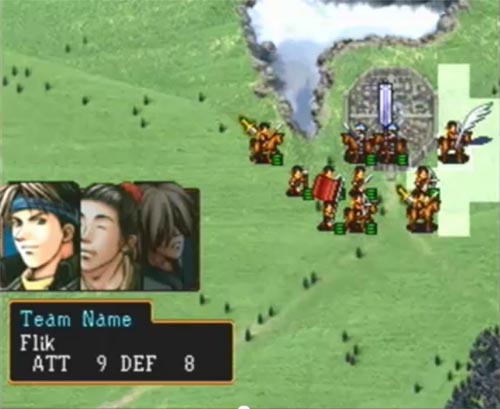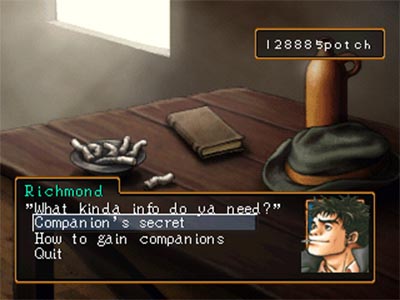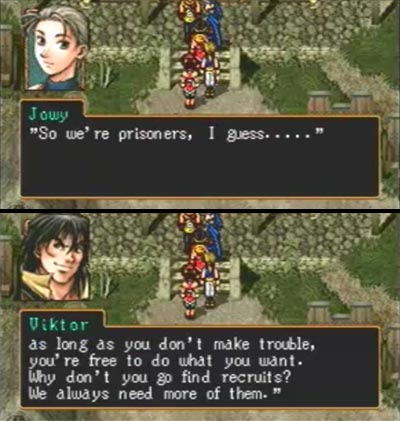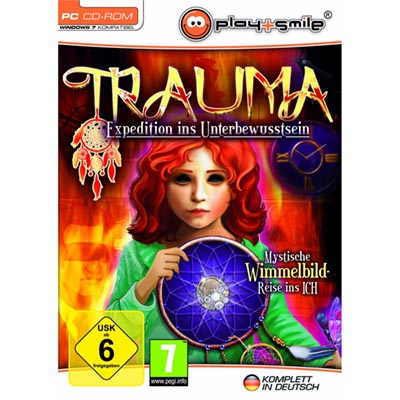WARNING: This is a post, where I basically just rave on how awesome my car is. There may be some insight into games, but you have been warned.
So I bought myself my first car a couple of weeks ago. It’s a affordable, used Mazda MX-5 NC. I’m enjoying it a great deal.
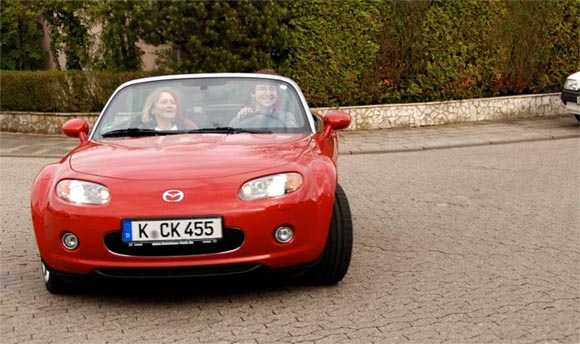
My Mum approves.
It is a bit of a unnecessary investment considering I don’t REALLY need a car and the previous one my Girlfriend had was still in working order. However, I am currently in a unique life situation where I can fully enjoy a car like this. So I decided to take the opportunity. And in the end, the apparent uselessness of the MX-5 is it’s whole point.
But before we go into that, some words on why I picked exactly that car. It’s because of a video game, of course. Gran Turismo 3 to be exact. GT3 was one of the first games I picked up back then when I got myself a PS2. I was way behind on consoles at that point and I really had a lot of catching up to do. The car that really made an impression on me back then was the Dodge Viper – a massive, overpowered American 2-seat super sports car with a bonnet that never ends and a retractable rooftop. It was one of the great, iconic boyhood dream cars of the 90ies. I mean, it even had it’s own, cheesy TV series.
Of course, I could have never afford a Dodge Viper. It’s an impossible car to maintain in Europe anyway. But you know what? I soon realized that the MX-5 NB kinda looked like a baby Dodge Viper. And that’s how it started…
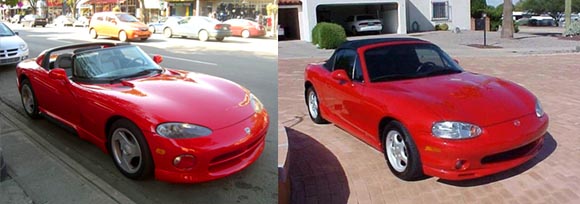
Dodge Viper compared to an MX-5 NB. Close enough.
But I was a long way from being able to buy my own car. I played a lot of Gran Turismo 3 in the meantime. One of the really great features about the game were the car descriptions. Something they later removed in Gran Turismo 4. Some of the cars had quite exhaustive car descriptions. It was there where I first stumbled across the surprising history of the MX-5. In many ways, it’s a car that paved the way for car design of the 90ies – conceptually and aesthetically.
Let’s rewind to the 80ies. Atfer the oil crisis most car manufacturers went heavily for practicality and economy. Perhaps the one car that describes the 80ies the best would be the VW Golf. It’s square so it’s easy to manufacture and to service. It’s super-practical too – it can be used for all sorts of purposes. It has room for 5 people. It’s a hatchback so it has a huge boot. Seats fold over to increase storage space even more.
It was during that time where the people at Mazda realized that there was something missing. Among all the practicality, cars kinda lost a sense of fun. Not that there were no fun cars in the 80ies. But almost all of them were expensive super sports cars well outside of reach for a normal buyer.
Contrast this to the 60ies, where you could buy lots of cheap, small roadsters like the Lotus Elan, MG MGB, Triumph Spitfire or the Alfa Romeo Spider. Sure, they were sports cars. But they were not sports cars like the Lamborghini Countach or the Ferrari 308 GTB
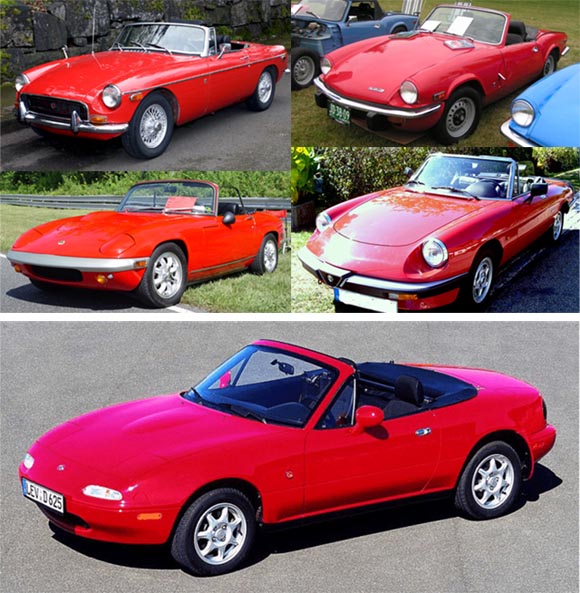
Who’s your daddy? MG MGB, Triumph Spitfire, Lotus Elan, Alfa Romeo Spider and MX-5 NA.
So Mazda did a smart thing. They decided to go blue sky and fill that void. They created a 60ies roaster by the end of the 80ies. An unlikely match. Japanese cars weren’t known for their charm. But they were chap and reliable. And apart from the persistent Alfa Romeo Spider the MX-5 had no competition at all. It was an instant success and it is today the best-selling 2-seat convertible car in the world.
During my studies, as I became aware of the car’s significance, I was considering getting a used MX-5 NA. It was the first version they released and you could get them for almost no money at all. A big draw were certainly the pop-up headlights – a clear indication of how cool a car is. Something I learned very early on in my childhood.
The hammer dropped in 2010 when we went to the GDC in San Francisco. My GF, well aware of the terminal stage of my obsession, found a car rental and we got an MX-5 to drive down the Highway 1. It was neither the pop-up headlights NA nor the baby Dodge Viper NB. It was the newest MX-5 NC. I never considered the NC before. It seemed like one of the many revivals like the New Beetle or New Mini. They tend to make the cars just bigger, more expensive and less quirky. Not so much with the MX-5 NC. I immediately fell in love with it. It fit like a glove and it delivered every promise I have ever read about it. All the Gran Turismo 3 descriptions, all the Top Gear episodes, all the Wikipedia articles fell into place.
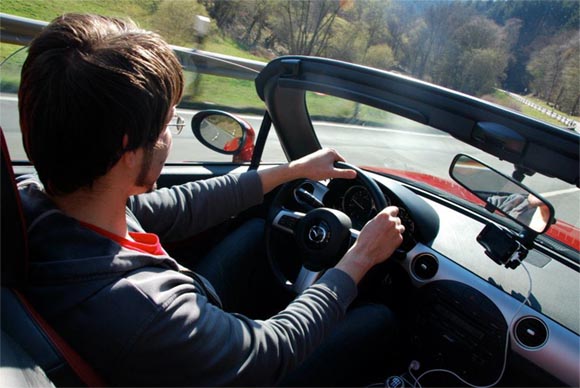
No matter what Gran Turismo says, it’s a far cry from the real thing.
What does this have to do with games?
There is an interesting lesson about the design of interactive experiences in here. You see, the super sports cars in the 80ies seemed to focus on performance. Almost all of them tried to maximize speed, grip and braking power because it seemed like all of these were important for “fun”. Yet, “fun” is an elusive beast. Something that is much more subjective and can’t be really maximized this way.
Here is the thing about the MX-5. It’s a FUN CAR. It’s a machine that can produce genuine joy at the press of a button or a pedal. Every singe time I get behind the wheel, I start grinning like an idiot just after the first few meters. And that’s even when I’m going for groceries. That’s even when it’s raining. And it’s not just me, my GF observed the same phenomenon. And as much I would like to, I can’t put my finger on why that is. Technically there is nothing about the car that stands out as unique or remarkable.
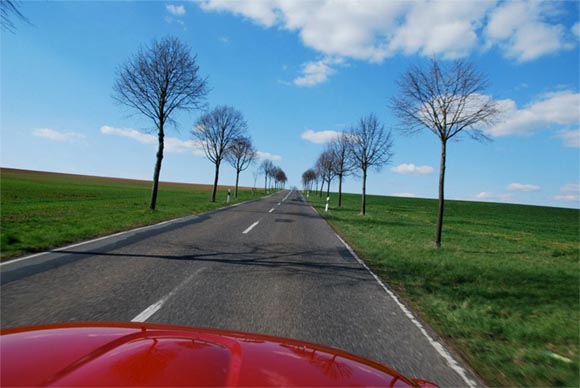
Whatever the thing is that makes MX-5 fun, it gets better on roads like this. (pic by Veronika Barth. Check out her website for large version.)
It seems to be a combination of the low driving position close to the pivot point, just the right amount of power compared to the low weight, the responsiveness of the steering, the joystick-like short gear stick located in the perfect distance from your body, the open top that lets you enjoy the sun, the cheeky headlamps. It’s not that one single thing that makes the difference. It’s a myriad of little things that create this particular symphony.
Which is one of the reasons why I dislike using the word “fun” when talking about games. It’s a good word for the consumers and perhaps ever for the critics. But if game designers use it, they tend to spread dangerous implications about what “fun” is. Using the word implies that it’s something simple. It implies that it’s something that can be optimized. In the end, it also implies that there is just one way to do it, one way to understand it, one brand of fun. It’s misleading, limiting, disingenuous and elitist. It’s the thing you would say if you had no idea what you are talking about. The kind of thing a Lamborghini driver would have said in the 80ies.
The other lesson in here is that games can do a hell of a job to sell cars and I dread the day when car manufacturers really take advantage of this.

